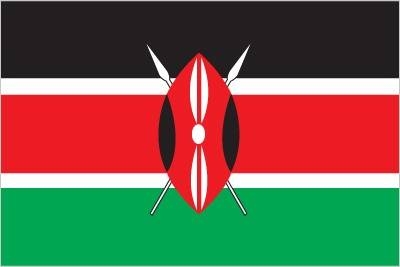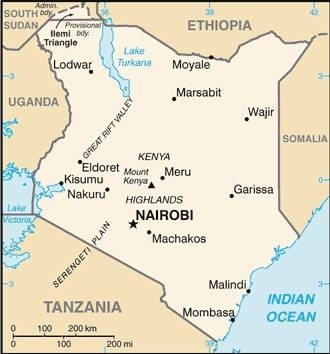202 Kenya

Three equal horizontal bands of black (top), red, and green. The red band is edged in white. A large Maasai warrior’s shield covering crossed spears is superimposed at the center. Black symbolizes the majority population, red the blood shed in the struggle for freedom, green stands for natural wealth, and white for peace. The shield and crossed spears symbolize the defense of freedom.
Flag courtesy of the CIA World Factbook

Map courtesy of the CIA World Factbook

Zebra Herd in Masai Mara National Reserve.
Photo courtesy of the CIA World Factbook
Government
According to Britannica, Kenya became independent on December 12, 1963, under a constitution that placed the prime minister at the head of a cabinet chosen by a bicameral National Assembly. Significant power was granted to assemblies elected in each of the country’s regions, and multiparty contests were allowed. Beginning in the early 1960s, however, a series of amendments abolished the regional assemblies in favor of provincial commissions appointed by the national government, made the National Assembly a unicameral body, proclaimed the Kenya African National Union (KANU) the only legal political party, and replaced the prime minister with an executive president who had the power to dismiss at will the attorney general and senior judges. The effect of these changes was to establish the central government, in particular, the presidency, as the principal locus of political power in the country. Although the constitution guaranteed a number of rights, such as the freedoms of speech, assembly, and worship, it also allowed the president to detain without trial persons who have been deemed a threat to public security.
Constitutional reforms allowed multiparty politics once again in 1991 and granted greater freedom to political parties before the December 1997 elections. In 2008, in the aftermath of the disputed December 2007 presidential election, legislation was passed that provided for the creation of a coalition government and amended the constitution to alter the structure of the executive branch, allowing for the re-creation of the prime minister post and the creation of two deputy minister posts. A new constitution was promulgated in 2010. Changes included a reduction in the power of the presidency, the elimination of the prime minister post after the next round of elections, the reestablishment of a bicameral parliament, provisions for a new decentralized government structure based on counties, and the addition of a bill of rights for Kenyans.
Under the 2010 constitution, the executive branch is headed by the president, who is the head of state and government and is assisted by the deputy president and the cabinet. The president is elected by direct popular vote and must win more than 50 percent of all votes as well as at least 25 percent of the votes cast in each of more than half of the country’s counties. The president’s term is five years, and there is a limit of two terms.
The 2010 constitution provides for a bicameral parliament, consisting of the 68-member Senate and the 350-member National Assembly. Most Senate members are directly elected by voters in their respective counties, and 20 nonelective seats are filled by nominees from the political parties with an elected presence in the Senate, with the number of nominees selected from a party’s list proportionate to the party’s share of elected seats, to represent special interest groups: 16 seats are reserved for women; 2 are reserved for a male and a female representative of the youth; and 2 are reserved for a male and a female representative of people with disabilities. There is also an ex officio member, the speaker. The majority of National Assembly members are directly elected. There are an additional 47 seats that are reserved for women, each of whom is elected from her respective county; 12 nonelective seats that are filled by nominees from the political parties with an elected presence in the National Assembly, with the number of nominees selected from a party’s list proportionate to the party’s share of elected seats, to represent special interest groups; and an ex officio member, the speaker. Members of both bodies serve five-year terms.
For administrative purposes, Kenya is divided into 47 counties, which are headed by directly elected governors. Each county has an assembly, which is composed of directly elected members, non-elected members who are selected after being nominated by political parties, their numbers proportionate to each party’s share of elected seats in the assembly, to represent special interest groups and to ensure that no more than two-thirds of the assembly members are of the same gender, and an ex officio speaker. Assembly members serve five-year terms.
Counties were introduced as the units of a new decentralized government structure in the 2010 constitution. The county structure began to be phased in after county governor elections were held in 2013. Kenya was previously divided into eight provinces: Nyanza, Western, Rift Valley, Central, Eastern, North Eastern, Coast, and Nairobi. Under the constitution, the transfer of authority to the county government system was expected to occur within three years of the 2013 elections. A new government body, the Transition Authority, was created and charged with facilitating the process.
The 2010 constitution provided for the creation of a Supreme Court, which was established in 2011. It has jurisdiction over all electoral disputes and disputes relating to the presidency; it also hears appeals from lower courts. Other courts include the High Court, which has full civil and criminal jurisdiction and rules on constitutional matters, the Kenya Court of Appeal, which hears appeals from lower courts, and magistrates’ courts at local levels. Kenya’s judicial system acknowledges the validity of Islamic law and indigenous African customs in many personal areas such as marriage, divorce, and matters affecting dependents. To that end, the Muslim community uses judicial venues known as Kadhis’ courts to resolve issues concerning Islamic law.
Kenya Civil Aviation Authority (KCAA)
Kenya Civil Aviation Authority (KCAA) was established on 24th October 2002 by the Civil Aviation (Amendment) Act, 2002 with the primary functions towards; Regulation and oversight of Aviation Safety & Security; Economic regulation of Air Services and development of Civil Aviation; Provision of Air Navigation Services, and Training of Aviation personnel KCAA; as guided by the provisions of the convention on international civil aviation, related ICAO Standards and Recommended Practices (SARPs), the Kenya Civil Aviation Act, 2013 and the civil aviation regulations.
Airspace
SkyVector – Google Maps – ADS-B Exchange
ICAO countries publish an Aeronautical Information Publication (AIP). This document is divided into three parts: General (GEN), En Route (ENR) and Aerodromes (AD). ENR 1.4 details the types of airspace classes they chose to adopt from classes A through G.
Kenya eAIP – requires login
Drone Regulations
The Civil Aviation (Unmanned Aircraft Systems) Regulations, 2020
Unmanned Aircraft Systems – Manual of Implementing Standards
Unmanned Aircraft Systems – Regulatory Fees and Charges
Unmanned Aircraft Systems Resellers/Distributor
Remote Air Operator Certificate (ROC)
Unmanned Aircraft Systems Training Organizations (UTO)
AUTONOMOUS UNMANNED AIRCRAFT VEHICLE (UAV) OPERATING PROCEDURES-ZIPLINE OPERATIONS – WESTERN KENYA
Advanced Air Mobility (AAM) Regulations & Policies
None found by the author.
However, should you, the reader, happen to stumble across something to the contrary, please email the author at FISHE5CA@erau.edu and you may be mentioned in the ACKNOWLEDGEMENTS section of this book by way of thanks for contributing to this free eBook!
Advanced Air Mobility (AAM) News
2025
Video courtesy of Advanced Air Mobility Institute from the January 2025 Global AAM Forum. Complete session for Day 2 of this Forum is available on the Advanced Air Mobility Institute YouTube Channel
Short Essay Questions
Scenario-Based Question
You have been hired by a Drone Startup Company. Your boss has immediately assigned this job to you.
They need you to prepare a one-page memo detailing the legalities of using a drone to film zebra in the Reserve, pictured above.
They need you to mention any national laws and local ordinances.
They specifically want to know what airspace (insert pictures) you will be operating in and whether or not you need an airspace authorization.
Does it matter whether or not you are a citizen of the country?
Lastly, there is a bonus for you if, as you scroll through this chapter, you find any typos or broken links!
Short Essay Questions
- What are the drone categories?
- How is registration addressed?
- How is remote ID addressed?
- What are the model aircraft rules?
- What are the commercial drone rules?
- Are there waivers or exemptions to the rules? If so, for what?
- Would you share a link to an interactive airspace map?
- How is BVLOS addressed?
- How can you fly drones at night?
- How can you fly drones over people?
- Where do you find drone NOTAMs?
- What are the rules for drone maintenance?
- What are the rules for an SMS program?
- What are some unique rules not mentioned above?
- What are the C-UAS rules?
- What are the AAM rules?

